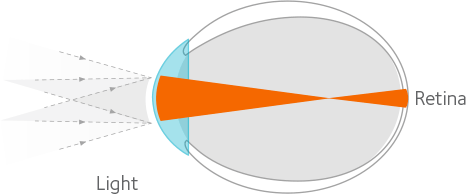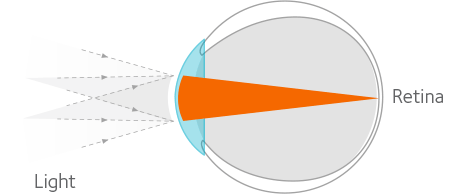
Providing the best-possible support for children's eyes is particularly important for those with rapidly progressing myopia.
That's why Myopia Management Solutions are specially designed for young children.
Today, we are facing a worldwide Myopia Epidemic. While genetics and less time being spent outdoors is a factor, science also points to the constantly changing vision demands while looking at screens.
So much of what we learn and achieve in life starts with sight.
Don’t let myopia (nearsightedness) stand in the way of your child being their best. Today’s children are more likely than ever to be myopic. It can impact the healthy development of your child’s eyes-and their future vision.
We are here to help you navigate all these options that are available. We are transparent about your child’s needs. We will always question ways, processes, mechanisms and materials to provide your child with the most innovative technologies available.
What is Myopia?
A patient with myopia will be able to see objects nearby clearly but will have trouble discerning objects that are further away.
Myopia, also known as nearsightedness, is a serious and widely prevalent eye condition. Globally, this condition affects over a billion people. That number is expected to increase to nearly 5 billion by 2050.
“Myopia Management” is the umbrella term used to describe the methods used to slow the progression of myopia.
This is a newer field in the eye care field, based on extensive research from doctors and scientists from around the world.
There are several options available that have effectively slowed down the progression of myopia in children.





Levels of Myopia:
- Mild myopia: -0.25D to -3.00D
- Moderate myopia: Between -3.00D to -6.00D
- High myopia: More than -6.00D
The reason objects are blurry in the distance with nearsightedness is because the eye becomes longer as the child grows.


FAST FACTS:
- Myopia is more commonly referred to as nearsightedness, or the inability to see objects clearly at a distance
- Myopia can worsen as your child's eyes continue to grow
- Early treatment of this condition have been shown to slow down its progression.
- Myopia Control Can Prevent Risk of Ocular Disease
- Vision may quickly deteriorate at a rate of one diopter per year and turn into high myopia.
- Children are not likely to recognize vision problems like myopia-it’s up to you, the parent.
- Myopia is 1 of the 5 ocular conditions identified as immediate priorities.
(World Health Organization’s Global Health Initiative for the Elimination of Avoidable Blindness)
What are the risks associated with Myopia?
Myopia can develop rapidly as children grow, putting them at an increased risk of becoming highly myopic, leading to more serious vision problems in adulthood.
In a worst-case scenario the high myopia increases the risk factors for:
- Cataracts:
The rate of progression of myopia has been linked to the development of cataracts. The higher the level of myopia in a child, the faster the rate cataracts can develop when they get older. - Glaucoma:
Glaucoma is when the eye develops an unusually high pressure, where this pressure can damage the optic nerve and cause vision loss. Studies have shown that nearsighted people have a 2-3x greater risk of Glaucoma. - Detached Retina:
Levels of myopia also have a correlation to detached retinas. A detached retina is when the retina pulls away from the eyes tissue, often resulting in permanent vision loss.
Early treatment of this condition have been shown to slow down its progression and help prevent the most serious consequences.
(Information Source-myopiamanagment.org)
If you aren’t sure whether your child is potentially at risk due to Myopia, consult with an eye doctor to find out!
What is myopia control for children - and why it's important - My Kids Vision
MYOPIA * Prevention and Control
Myopia Prevention: Is reading a factor in myopia development?

